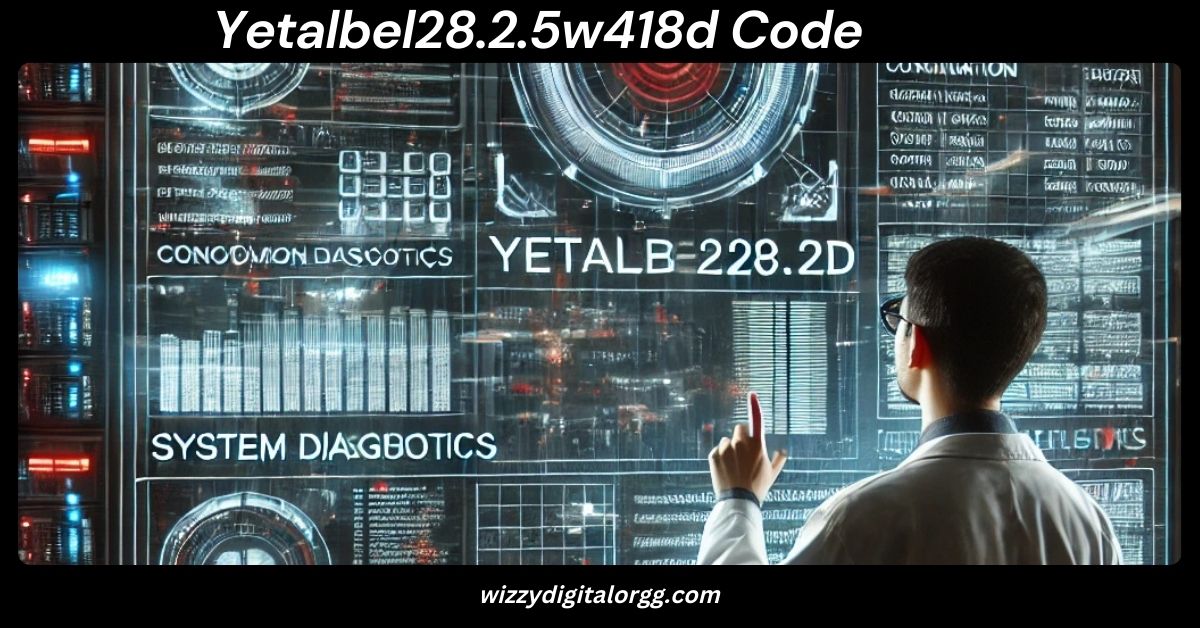
In the realm of software applications, encountering cryptic error codes can be both perplexing and frustrating. One such enigmatic code is the Yetalbel28.2.5w418d code, which signifies a configuration mismatch between system components. This article delves deep into the intricacies of this code, offering insights into its structure, causes, implications, and solutions.
Deciphering the Yetalbel28.2.5w418d Code
The Yetalbel28.2.5w418d code is an alphanumeric sequence that provides specific information about a system’s configuration issue. Breaking it down:
- Yetalbel: Identifies the affected system component.
- 28.2.5: Specifies the software version release.
- w418d: Pinpoints the exact configuration parameter in question.
This structured format aids in quickly identifying and addressing the root cause of the configuration mismatch. Each segment of the code is linked to specific internal system settings, helping software engineers and IT professionals diagnose errors efficiently.

Common Scenarios Leading to the Code
The Yetalbel28.2.5w418d code typically emerges in scenarios such as:
- Software Updates or Installations: Introducing new software or updating existing applications can lead to compatibility issues, triggering the code. When software updates introduce new dependencies or alter existing settings, they can conflict with prior configurations.
- Modifying System Settings: Altering configurations without proper validation may result in mismatches. Unverified settings may lead to unexpected behaviors, including failure to recognize essential system components.
- Hardware Configuration Changes: Upgrading or changing hardware components can disrupt system harmony. Newer hardware may require drivers or firmware that the existing software version does not support.
- Operating System Migrations: Shifting to a new OS version might introduce unforeseen compatibility challenges. Certain legacy software components may not be optimized for newer operating system frameworks.
Also Read: Introduce in Presentation: A Step-by-Step Guide for a Great First Impression
Technical Specifications and Origins
The Yetalbel28.2.5w418d code originates from the system’s registry database. It surfaces when specific configuration values deviate from the software architecture’s predetermined parameters. Understanding its structure facilitates:
- Identifying affected components.
- Determining the involved software version.
- Locating problematic configuration settings.
- Implementing appropriate fixes based on precise error parameters.
Automated diagnostics and error monitoring systems detect this code, alerting users to potential configuration conflicts requiring attention. These systems utilize predefined log files and machine-learning algorithms to identify potential trends associated with the error code, aiding in proactive maintenance.
Key Components of the Code System
The Yetalbel28.2.5w418d code system comprises interconnected elements ensuring system configuration integrity.
Essential Parameters and Variables
Primary parameters include:
- System Identifier (‘Yetalbel’): Pinpoints specific software modules and their dependencies.
- Version Number (‘28.2.5’): Indicates the software release, which helps in tracking changes and updates that may have led to the issue.
- Configuration Code (‘w418d’): Specifies the exact configuration parameter that is conflicting, allowing for targeted troubleshooting.
These parameters monitor critical variables such as:
Also Read: Teamviwer Alternatives for Remote Access and Support (2025)
- Memory Allocation Limits: Ranges between 128MB-512MB, ensuring the software does not exceed the permitted limits.
- Registry Entry Paths: Located at /system/config/yetalbel/, defining where configuration settings are stored.
- Configuration Timestamps: Utilize UTC format to log changes accurately.
- Access Permission Levels: Scale from 0-5, determining which users or system processes can modify settings.
Dynamic variables include cache storage allocation, thread priority settings, resource utilization thresholds, and system state flags. Each variable plays a crucial role in ensuring seamless system performance without conflicts.
Core Functions and Methods
The code system operates through five main functional components:
- ValidationEngine: Verifies parameter integrity by cross-checking predefined limits against the current system state.
- ConfigParser: Interprets system settings and flags inconsistencies before applying new configurations.
- StateManager: Tracks configuration states, enabling rollback options in case of errors.
- ErrorHandler: Processes configuration conflicts and logs relevant details for analysis.
- DataLogger: Records system changes, ensuring compliance with security and operational standards.
Each function employs specific methods like checkSystemState(), parseConfigData(), updateRegistry(), logConfigChanges(), and validateParameters(). These functions communicate through standardized API calls using JSON-formatted data packets for consistent error reporting and debugging.
Common Applications and Use Cases
The Yetalbel28.2.5w418d code system serves multiple industries with its advanced configuration management capabilities.
Also Read: Concurrent TeamViewer: Everything You Need to Know
Industrial Implementation
Manufacturing facilities utilize this code in automated production lines to monitor equipment configurations. The system integrates with industrial control systems to track machine settings, calibration parameters, and operational thresholds.
Large-scale manufacturing plants employ this code for quality control processes, ensuring consistent product specifications across multiple production units.
Chemical processing plants rely on it for maintaining precise reaction parameters through automated validation checks. The code enables real-time monitoring of critical system variables in power generation facilities, enhancing operational safety protocols.
Research Applications
Research institutions implement the Yetalbel28.2.5w418d code in laboratory automation systems for experimental data validation. The code monitors environmental parameters in climate research facilities, maintaining experimental integrity through precise configuration tracking. Biomedical laboratories utilize the system for equipment calibration verification in sensitive testing procedures.
Data centers employ it to manage server configurations across distributed research networks. The code’s validation engine supports reproducible research by maintaining consistent experimental parameters across multiple study sites.
Troubleshooting and Fixes
Diagnosing the Issue
- Check system logs for recent configuration changes that may have triggered the code.
- Run an integrity scan using built-in diagnostic tools to detect corrupted settings.
- Cross-check registry values against the software documentation for discrepancies.
- Consult system documentation to determine compatibility between hardware and software components.
Resolving the Code Error
- Revert to Default Configurations: Reset system settings to default values to eliminate inconsistencies.
- Update Software Components: Install the latest patches and drivers to ensure compatibility.
- Modify Registry Entries: Adjust configuration values to match the correct parameters outlined in system documentation.
- Perform a System Restore: Rollback to a stable system state if previous solutions fail.
- Consult Vendor Support: If the issue persists, contacting the software vendor may be necessary for further assistance.
Also Read: 6xgames: The Ultimate Guide to Unblocked Online Gaming
Frequently Asked Questions (FAQs)
What does the Yetalbel28.2.5w418d code mean?
It indicates a configuration mismatch within software components, often arising from updates or settings changes.
How can I fix the Yetalbel28.2.5w418d code error?
By checking system logs, updating software, resetting configurations, and modifying registry settings.
Is the Yetalbel28.2.5w418d code related to hardware?
Yes, it can arise from hardware changes that impact system configurations.
Can this code be ignored?
No, ignoring it may lead to performance issues and software malfunctions.
Does this error affect all operating systems?
It primarily affects Windows and Linux-based systems but can also appear on macOS.
Conclusion
The Yetalbel28.2.5w418d code is a critical system indicator that helps users identify and resolve configuration mismatches in software applications. By understanding its structure, causes, and troubleshooting methods, users can efficiently diagnose and fix related issues.
Whether applied in industrial settings, research institutions, or IT environments, this code ensures optimal system performance and stability. Addressing it proactively can prevent potential software malfunctions and improve overall system reliability.



